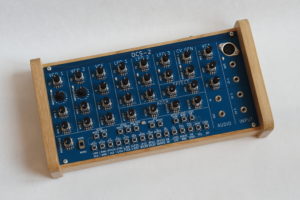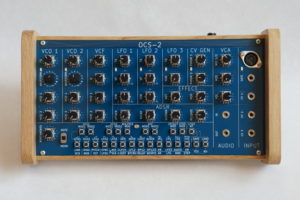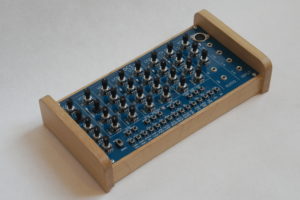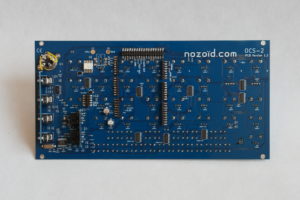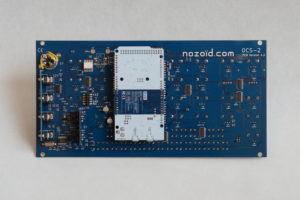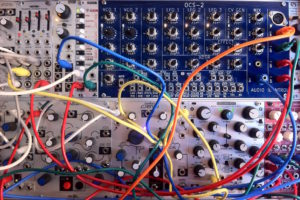OCS-2 is a digital, semi-modular, analogue style synthesizer. Small, but very powerful and flexible, it provides an incredible sound quality. Dedicated to knob addicts, this synthesizer is full of features that define its own unique sound.
Why is it so special?
First, the sound quality is impressive. This is not a cheap 8 or 16 bits synthesizer : it implements state of the art audio synthesis algorithms.
OCS-2 provides a lot more than a modern dual oscillator monosynth. There are a lot of unique features :
- 30 control knobs
- Few atypical waveforms with incredible fat sound
- LFO that can continuously change waveform
- A CV generator with different algorithms to generate random to rythmic modulation
- 4 audio effects
- A very powerful digital connection matrix
- A light sensor to control sound with hand gesture
- Software customization
- Very compact
- Incredible sound quality
What is inside?
- 2 VCO providing 15 different waveforms
- 1 VCF : multi-mode, including a 24db/octave low pass resonant filter
- 1 VCA
- 1 ADSR
- 3 LFO : 2 with configurable waveform, 1 with CV frequency control
- 1 custom CV generator with 4 algorithms : Attack Release, dual LFO, Random, Step
- 1 audio effects processor with 4 effects : Distortion, Delay, Bitcrush, Waveshaper
- 1 ring modulator
- 1 CV controlled mixer for VCO1 and VCO2
- 2 octaves keyboard with portamento
- 1 digital matrix to connect signals to modulation potentiometers
- 1 stereo line-IN with envelope follower and gate control
- 1 MIDI input : note / velocity / pitch bend / modulation wheel / control change
- 3 analogue CV IN and 1 GATE IN
- 1 light sensor
Why will you love it?
Since it is very small, you can carry this synthesizer everywhere. With an embedded audio multi-effect, you don’t need anything else!
But this synthesizer can also adapt to your setup : add a midi keyboard and you are ready for endless jams. OCS-2 is also perfect as a computer complement : prepare some midi loops and use them in combination with the modulation potentiometers as CV controls. With a line audio input, 3 analogue Control Voltage in, and one 0/5V Gate IN, OCS-2 can also be a great addition to your modular setup.
The extensive number of physical controls allows an easy and effective sound tuning. 30 potentiometers provide a direct access to all sound parameters, so you can focus on the music.
The light sensor is also great for musical expressivity : use the shade of your hand to control your sound! Your performance on stage will never be the same thanks to this feature. This is also attractive for studio work since it introduces a very different control than a potentiometer rotation.
Users comments
- “I’m blown away by how well you can make this little box sing” Bogdan Raczynski
- “it’s a monster!” Fabien Alea
- “This magical box is made with a perfect ergonomy” Vincent Epplay
- “excellent synth – i tested : it’s unique …” Franck Vigroux
- “I love it, this machine is alive!” Nsdos
- “I think it’s fantastic” Nelson Baboon
- “It’s going to be a central piece in my setup” UndercoverBrother
- “This is an incredible little synth…” Neuroportal
- “Badass architecture sounds pretty nice. Huge range of sounds!” Thierry Toborek
- “Excellent. My walls were alive with this little blue monster.” Nick Farell
- “OSC-2 is the best thing for expressing myself through music since I got a larynx and a computer! Its interface is so clever! Its sound soooo FAT! So many possibilities for endless joy! <3” Jérémie Zimmermann
- “I think the ocs-2 and me become long time friends because it sounds great and the mod matrix is the most clever one I’ve seen! :)” Martin Stimming
- “It’s a fascinating instrument and my first digital synth with such potential.” Guido Studer
Raw sounds
Alea.f had fun turning knobs. All following sounds are 1 track, unedited, raw recordings of OCS-2.
Audio routing

This is the audio path wired inside the synthesizer.
Dual VCO with 15 different waveforms

Available waveforms are a mix of classic ones: sinus, triangle, saw, square, pulse, PWM, noise – and less common ones : (sinus+1)², double saw, squared ramp, digital noise – and even some that haven’t been named yet.![]()
![]()
![]()
![]()
Example of waveforms developed specially for this synthesizer:![]()
![]()
2 modulation potentiometers allow to modulate VCOs frequency with the CV connected via the digital connection matrix.
VCO 1 and 2 frequencies can be adjusted separately, or linked together. In this case VCO 2 frequency potentiometers tune between 0-1 octave against VCO 1 frequency.
All waveforms are band-limited to remove digital synthesis artefacts.
A ring modulator option mixes the signal of the 2 VCOs.
PWM is controlled via LFO1 or LFO2 depending on the VCO.
Noise color can be adjusted using the VCO frequency control.
The 16th waveform is the audio in : Left for VCO1, right for VCO2.
VCO wavefoms video demonstration
Multi-mode Moog-like VCF

The VCF is a custom version of the Moog filter. It mimics its most important features :
- 24dB low pass / resonant frequency response
- high resonance creating auto-oscillations
- no amplitude increase with high Q
This filter has some specific features :
- No distortion of the signal, allowing a clear pass-through.
- 4 frequency responses are available : the classic Low Pass 24dB/Octave is the default configuration, but there is also a Low Pass 12dB/Octave, a Band Pass 12dB/Octave, or a High Pass 12dB/Octave.

2 LFOs with variable waveform

These two LFOs offer a unique feature : you can adjust the shape of the CV using potentiometers instead of switches. This allows to continuously change from a rising saw, to a triangle and then to a slope down. Or stop halfway between sinus and square.

The waveform (WF) potentiometer controls the shape of the transition. It changes from a straight ramp (like in triangle or saw), to a sudden change of value (like in a square), passing through a sinusoid shape.
The other potentiometer (SYM) adjusts the symmetry of the output, i.e the ratio between rise/fall times. It passes from a rising saw to a triangle and then a falling saw.
Frequency range of these LFOs is huge : the period can go from 45 seconds to 1/40 second.
When this LFO is synchronized with a GATE signal (from keyboard, or midi), the LFO phase is reset at the beginning of every note.
VCLFO with selectable waveform (LFO 3)


The 3rd LFO is completely different as it is wired to the gate and can trigger notes.
In addition to classic waveforms (sinus, triangle, square, pulse), it provides waveforms dedicated for simple rhythmic generation : [1 0], [1 0 0 0], [1 1 0 0], [1 1 1 0], [1 1 0 1 0], [1 1 1 1 0], [1 1 0], [1 1 0 0 1 0 0 0].
It also provides a random generator, because… well, it’s nice.
LFO 3 frequency range is the same than LFO 1 and 2, BUT it’s a VCLFO : LFO3 frequency can be controlled by another CV.
You can also add groove to your rhythm!
ADSR

This is a standard analog ADSR :

Attack, Decay, Sustain and Release can all be adjusted with potentiometers.
Custom CV Generator module
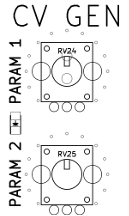
The CV Generator aim is to create modulation CV, just like a LFO. However the CV Generator is dedicated to more complex evolution. Moreover, you can use 4 different algorithm in this slot.
- AR : Attack Release envelop generator
The modulation is a standard analog type Attack-Release generator.
PARAM 1: Attack time / PARAM 2 : Release time. - LFO : Dual LFO
The modulation is the sum of 2 sinusoidal LFOs.
PARAM 1 : LFO frequency 1 / PARAM 2 : LFO frequency 2. - RND : Random generator
A random value, updated periodically is filtered using a low pass filter.
PARAM 1 : frequency of the random value generator / PARAM 2 : cutoff frequency the filter. - Step : a Step generator
This module generates strange rhythmical patterns that can mutate.
PARAM 1 : step frequency / PARAM 2 : steps evolution speed.
VCA

The VCA amplifies the filter output with the ADSR signal.
The MOD potentiometer can modulate the amplitude of the audio signal using one of the modulation CVs.
The MIX potentiometer allows to adjust the amplitude of VCO1 regarding VCO2.
The MOD potentiometer can also be used to modulate the MIX amount.
If the ring-modulator option is enabled, the MIX potentiometer mixes between VCO1 and the ring-modulator.
A master volume is also available.
Audio effects

You can choose one of the four available audio effects
- Distortion
WET : distortion amount. MOD : WET modulation. - Bit crush
WET : bit crush amount. MOD : WET modulation. - Delay
WET : level of audio sent to the delay line. It mixes between the VCA out and the delay line out.
At 0%, the delay does not have any effect.
At 50%, the delay line input is a mix between the VCF out and the delay line out.
At 100%, no external sound is sent into the delay line. Only the delay line out is sent to the delay line in.
MOD : delay time, ranging from almost 0 to more than 900ms.
Unlike the other effects, the delay is after the VCA in the audio chain. - Waveshaper
WET : Waveshaper amount. MOD : WET modulation.
Keyboard

When toggle is on NOTE, this is a 2 octaves keyboard controlling the frequencies of the VCOs. It also controls the frequency of the VCF if “PITCH VCF” option is ON. The portamento filters the frequency change of the keyboard.
When toggle is on MENU, the keyboard is used to patch the matrix and to edit all options.
Digital patching matrix
Connection between modules are made via a digital matrix. You will not be short of cables anymore, and you can even save your patch! The Matrix allows to connect any CV to any modulation potentiometer.
CVs are :
- VCO 1 out
- VCO 2 out
- LFO 1
- LFO 2
- LFO 3
- ADSR
- CV GENERATOR
- LIGHT sensor
- AUDIO IN envelope
- MIDI NOTE ON velocity
- EXTERNAL CV 1 (or MIDI pitch Bend)
- EXTERNAL CV 2 (or MIDI Modulation Weel (CC 1 + CC 33))
- EXTERNAL CV 3 (or MIDI CC 2 (+CC 34))
Modulation potentiometers are :
- VCO 1 MOD 1 and 2
- VCO 2 MOD 1 and 2
- VCF MOD 1 and 2
- VCA/MIX MOD
- LFO 3 MOD
- EFFECT MOD
Light Sensor

The light sensor is located near the keyboard :
Use the shade of your hand to control the sound! The light sensor generates a Control Voltage that can be routed to any modulation potentiometer thanks to the patching matrix.
Audio In
Audio in (stereo – line level) is plugged on the 16th waveform of the VCOs, it allows to input any audio source in the synthesizer audio path using a 3.5mm stereo jack plug. The audio signal can be used as any other waveform.
It can also be used to generate a CV thanks to an an envelope follower.
When AUDIO option is selected as GATE mode, a gate is triggered when the audio left signal is above a threshold.
External CV
3 analog inputs (-6v/6V) and an external GATE IN (0/5V) are available using 3.5 mono jacks, compatible with most modular setups.
MIDI
You can also control your synthesizer with a MIDI cable : using a keyboard to play notes, or the pitch bend or modulation wheel to control the sound. Connect an external sequencer, a computer etc. The midi data used is :
- Note On / Note Off – channel 1. Note On velocity is accessible in the digital patching matrix so you can use it like any other control CV.
- Pitch bend, modulation wheel (CC1 – 7 bits / CC1 and CC33 – 14 bits) and after-touch (CC2 – 7 bits / CC2 and CC34 – 14 bits) – channel 1. When sending one of this data in midi, the CV IN 1, 2 or 3 are disconnected from the analog input and connected to this midi data.
- Program change from 1 to 10 – channel 1 : load one of the memory.
- Control Change (1CC – 7 bits / 2CC – 14 bits) – channel 2 : control all potentiometers in midi. Midi data is added to potentiometer value to control the corresponding parameter. For 14 bits MIDI, use CC N for MSB, and CC N+32 for LSB. Always send MSB after the LSB.
- MIDI Clock : As soon as MIDI syncro signal (F8) is received : the LFO3 synchronize on this signal. Few seconds after you stop sending the syncro, or unplug the cable, the LF03 frequency goes back to a non synchro mode. During the synchro mode, the LFO FQ potentiometer change the frequency to 1/16, 1/8, 1/4, 1/2, 1, 2, 4 or 8 times the frequency of a MIDI note.
Specifications
- 30 potentiometers (12 bits input)
- 48KHz audio synthesis
- about 12KHz for CV computation
- 24 bits audio ADC and DAC
- 32 bits audio synthesis
- 12 bits ADC for the potentiometers and CV in
- about 80 dB S/N for the audio line-out
- 0.5 ms IN/OUT audio latency
- cortex M3 32 bits micro-controller (from an Arduino due)
- 9 to 12V DC power supply (1 standard 2.1mm power plug or 1 standard eurorack plug)
- low power consumption (300mA @ 12V)
- eurorack compatible (3U, 10 inches : 50HP)
- 280 x 150 x 60mm wood (oak) box
- about 620g
Documentation
Preset pages
Print these pages to “save” your potentiometer positions :
OCS-2_preset_page_A4
OCS-2_preset_page_A5
OCS-2_preset_page_A6

